YAMAHA FX HO CRUISER 2022 Manual Online
Manufacturer: YAMAHA, Model Year: 2022, Model line: FX HO CRUISER, Model: YAMAHA FX HO CRUISER 2022Pages: 136, PDF Size: 5.62 MB
Page 81 of 136
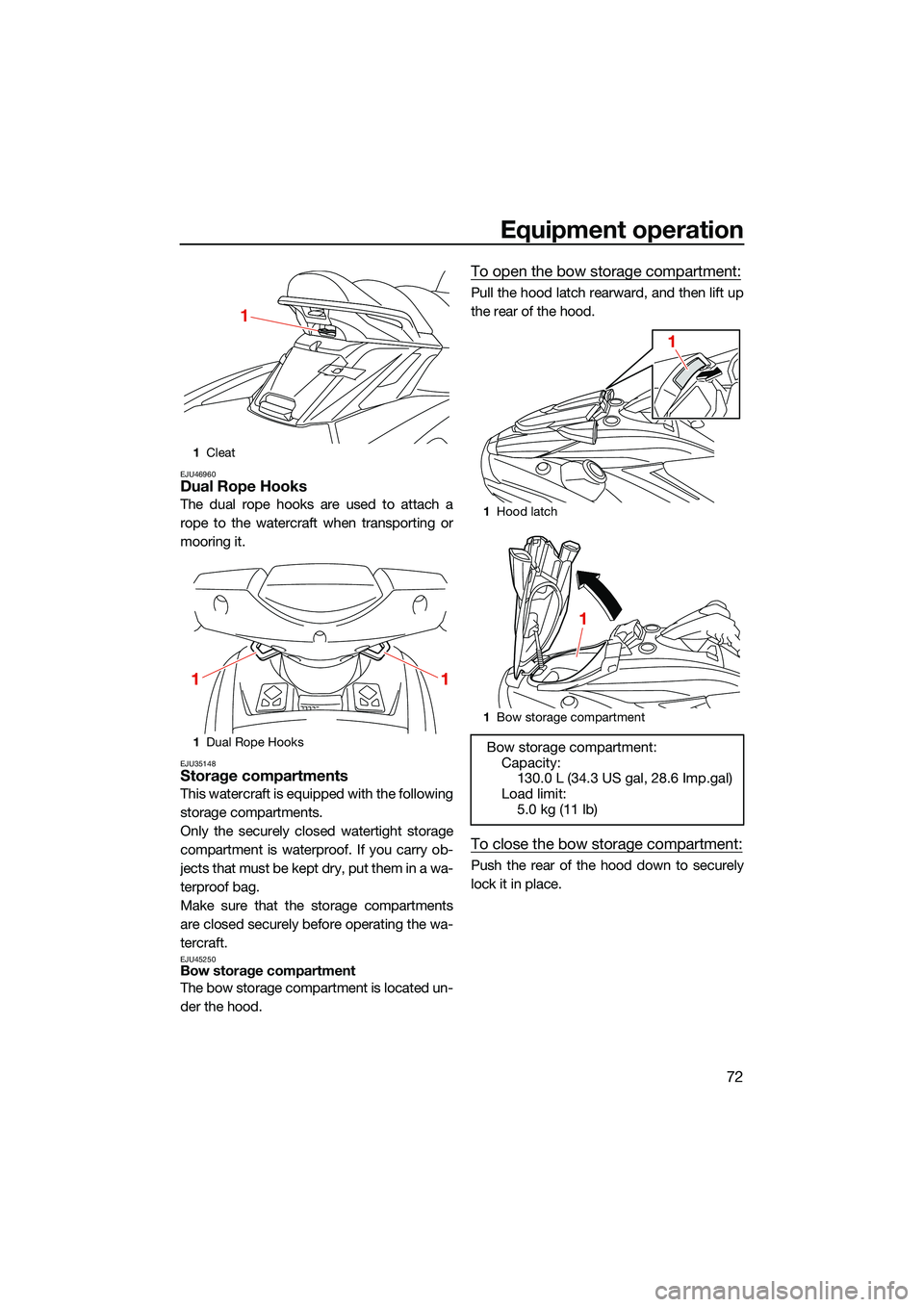
Equipment operation
72
EJU46960Dual Rope Hooks
The dual rope hooks are used to attach a
rope to the watercraft when transporting or
mooring it.
EJU35148Storage compartments
This watercraft is equipped with the following
storage compartments.
Only the securely closed watertight storage
compartment is waterproof. If you carry ob-
jects that must be kept dry, put them in a wa-
terproof bag.
Make sure that the storage compartments
are closed securely before operating the wa-
tercraft.
EJU45250Bow storage compartment
The bow storage compartment is located un-
der the hood.
To open the bow storage compartment:
Pull the hood latch rearward, and then lift up
the rear of the hood.
To close the bow storage compartment:
Push the rear of the hood down to securely
lock it in place.
1Cleat
1 Dual Rope Hooks
1
11
1Hood latch
1 Bow storage compartment
Bow storage compartment:
Capacity: 130.0 L (34.3 US gal, 28.6 Imp.gal)
Load limit:
5.0 kg (11 lb)
1
1
UF3V73E0.book Page 72 Friday, October 8, 2021 1:30 PM
Page 82 of 136
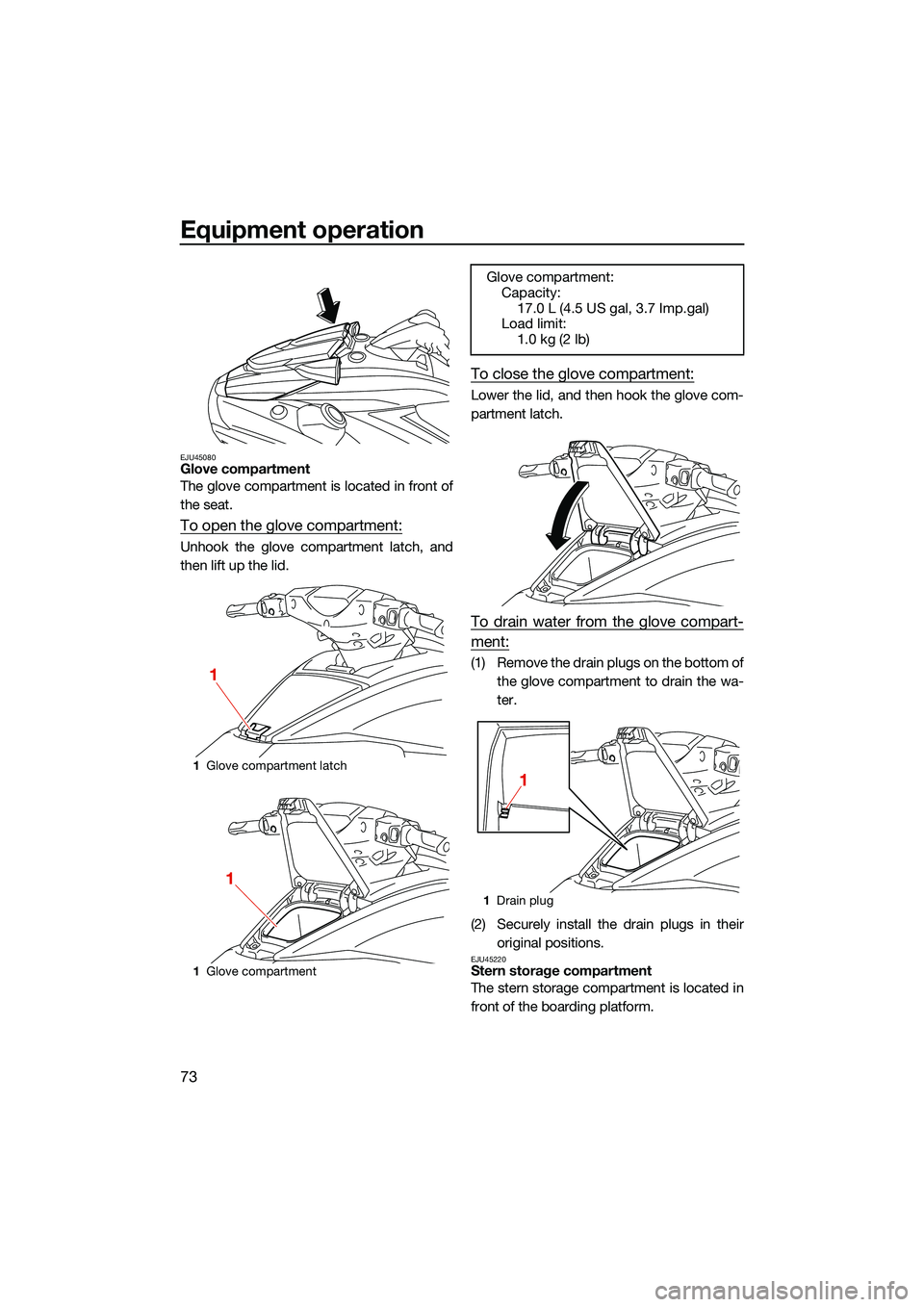
Equipment operation
73
EJU45080Glove compartment
The glove compartment is located in front of
the seat.
To open the glove compartment:
Unhook the glove compartment latch, and
then lift up the lid.
To close the glove compartment:
Lower the lid, and then hook the glove com-
partment latch.
To drain water from the glove compart-
ment:
(1) Remove the drain plugs on the bottom ofthe glove compartment to drain the wa-
ter.
(2) Securely install the drain plugs in their original positions.
EJU45220Stern storage compartment
The stern storage compartment is located in
front of the boarding platform.
1Glove compartment latch
1 Glove compartment
1
1
Glove compartment:
Capacity:
17.0 L (4.5 US gal, 3.7 Imp.gal)
Load limit: 1.0 kg (2 lb)
1Drain plug
1
UF3V73E0.book Page 73 Friday, October 8, 2021 1:30 PM
Page 83 of 136

Equipment operation
74
To open the stern storage compartment:
Unhook the stern storage compartment latch
on both sides, and then open the lid.
To close the stern storage compartment:
Close the lid, and then hook the stern storage
compartment latch on both sides.
TIP
The ski rope slot in the stern storage com-
partment lid can be used to store the rope in
the stern storage compartment while the
rope is attached to the cleat.
EJU35176Beverage holder
The beverage holder is located near the mul-
tifunction information center.
Do not place any items in the beverage hold-
er while riding. Otherwise, the items may fall
out of the beverage holder.
EJU37235Removable watertight storage compart-
ment
The removable watertight storage compart-
ment is located under the rear seat.
The compartment is watertight when the cap
is closed securely.
To open the removable watertight stor-
age compartment:
(1) Remove the rear seat. (See page 69 forseat removal and installation proce-
dures.)
(2) Loosen the cap and remove it.
1 Stern storage compartment latch
1 Stern storage compartment lid
2 Stern storage compartment
Stern storage compartment:
Capacity:
11.0 L (2.9 US gal, 2.4 Imp.gal)
Load limit: 1.5 kg (3 lb)
1
1
2
1Ski rope slot
1 Beverage holder
1
1
UF3V73E0.book Page 74 Friday, October 8, 2021 1:30 PM
Page 84 of 136
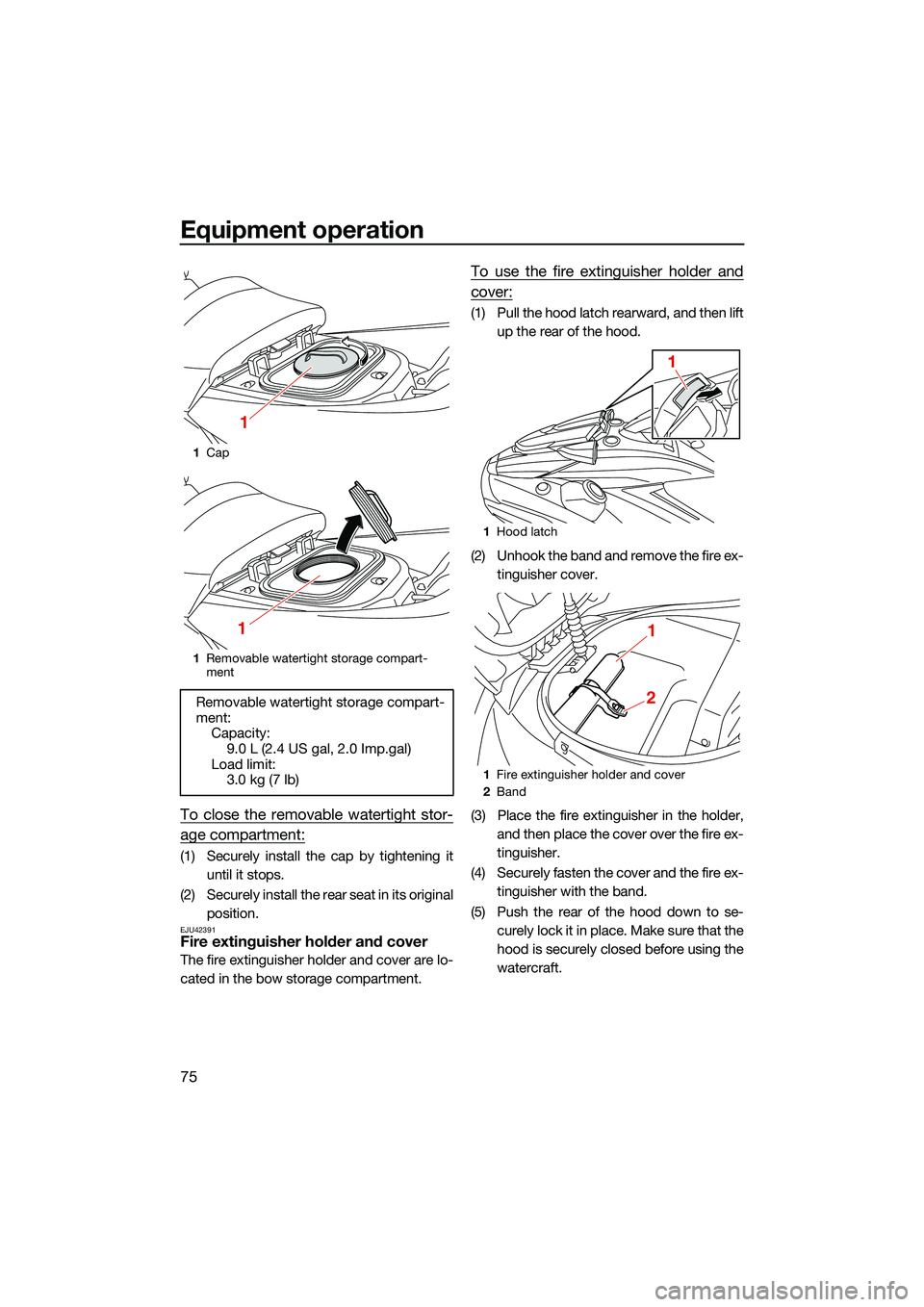
Equipment operation
75
To close the removable watertight stor-
age compartment:
(1) Securely install the cap by tightening ituntil it stops.
(2) Securely install the rear seat in its original position.
EJU42391Fire extinguisher holder and cover
The fire extinguisher holder and cover are lo-
cated in the bow storage compartment.
To use the fire extinguisher holder and
cover:
(1) Pull the hood latch rearward, and then liftup the rear of the hood.
(2) Unhook the band and remove the fire ex- tinguisher cover.
(3) Place the fire extinguisher in the holder, and then place the cover over the fire ex-
tinguisher.
(4) Securely fasten the cover and the fire ex- tinguisher with the band.
(5) Push the rear of the hood down to se- curely lock it in place. Make sure that the
hood is securely closed before using the
watercraft.
1Cap
1 Removable watertight storage compart-
ment
Removable watertight storage compart-
ment:
Capacity:
9.0 L (2.4 US gal, 2.0 Imp.gal)
Load limit: 3.0 kg (7 lb)
1
1
1Hood latch
1 Fire extinguisher holder and cover
2 Band
1
1
2
UF3V73E0.book Page 75 Friday, October 8, 2021 1:30 PM
Page 85 of 136
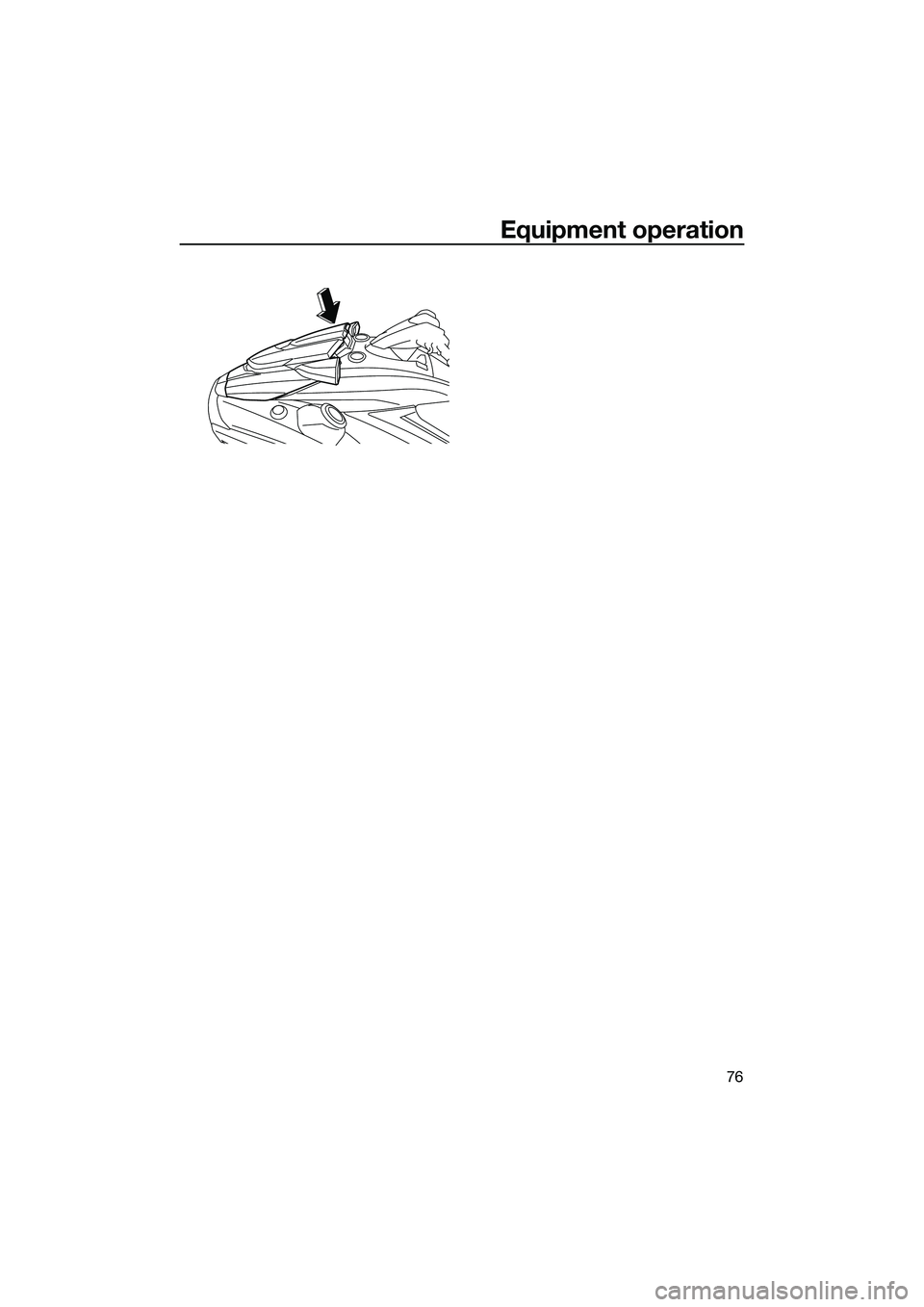
Equipment operation
76
UF3V73E0.book Page 76 Friday, October 8, 2021 1:30 PM
Page 86 of 136
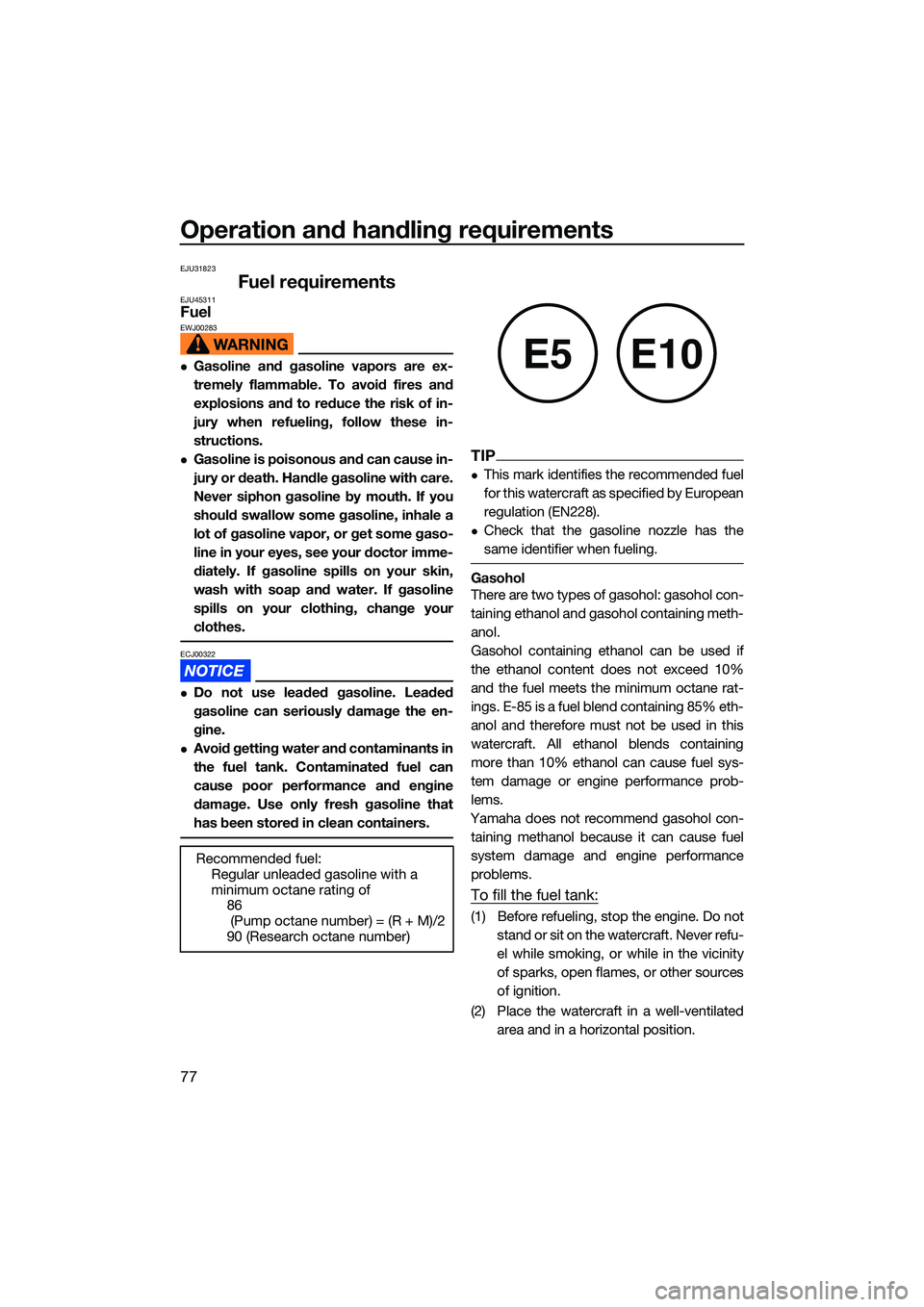
Operation and handling requirements
77
EJU31823
Fuel requirementsEJU45311FuelEWJ00283
Gasoline and gasoline vapors are ex-
tremely flammable. To avoid fires and
explosions and to reduce the risk of in-
jury when refueling, follow these in-
structions.
Gasoline is poisonous and can cause in-
jury or death. Handle gasoline with care.
Never siphon gasoline by mouth. If you
should swallow some gasoline, inhale a
lot of gasoline vapor, or get some gaso-
line in your eyes, see your doctor imme-
diately. If gasoline spills on your skin,
wash with soap and water. If gasoline
spills on your clothing, change your
clothes.
ECJ00322
Do not use leaded gasoline. Leaded
gasoline can seriously damage the en-
gine.
Avoid getting water and contaminants in
the fuel tank. Contaminated fuel can
cause poor performance and engine
damage. Use only fresh gasoline that
has been stored in clean containers.
TIP
This mark identifies the recommended fuel
for this watercraft as specified by European
regulation (EN228).
Check that the gasoline nozzle has the
same identifier when fueling.
Gasohol
There are two types of gasohol: gasohol con-
taining ethanol and gasohol containing meth-
anol.
Gasohol containing ethanol can be used if
the ethanol content does not exceed 10%
and the fuel meets the minimum octane rat-
ings. E-85 is a fuel blend containing 85% eth-
anol and therefore must not be used in this
watercraft. All ethanol blends containing
more than 10% ethanol can cause fuel sys-
tem damage or engine performance prob-
lems.
Yamaha does not recommend gasohol con- taining methanol because it can cause fuel
system damage and engine performance
problems.
To fill the fuel tank:
(1) Before refueling, stop the engine. Do not stand or sit on the watercraft. Never refu-
el while smoking, or while in the vicinity
of sparks, open flames, or other sources
of ignition.
(2) Place the watercraft in a well-ventilated area and in a horizontal position.
Recommended fuel:
Regular unleaded gasoline with a
minimum octane rating of86
(Pump octane number) = (R + M)/2
90 (Research octane number)
E5E10
UF3V73E0.book Page 77 Friday, October 8, 2021 1:30 PM
Page 87 of 136
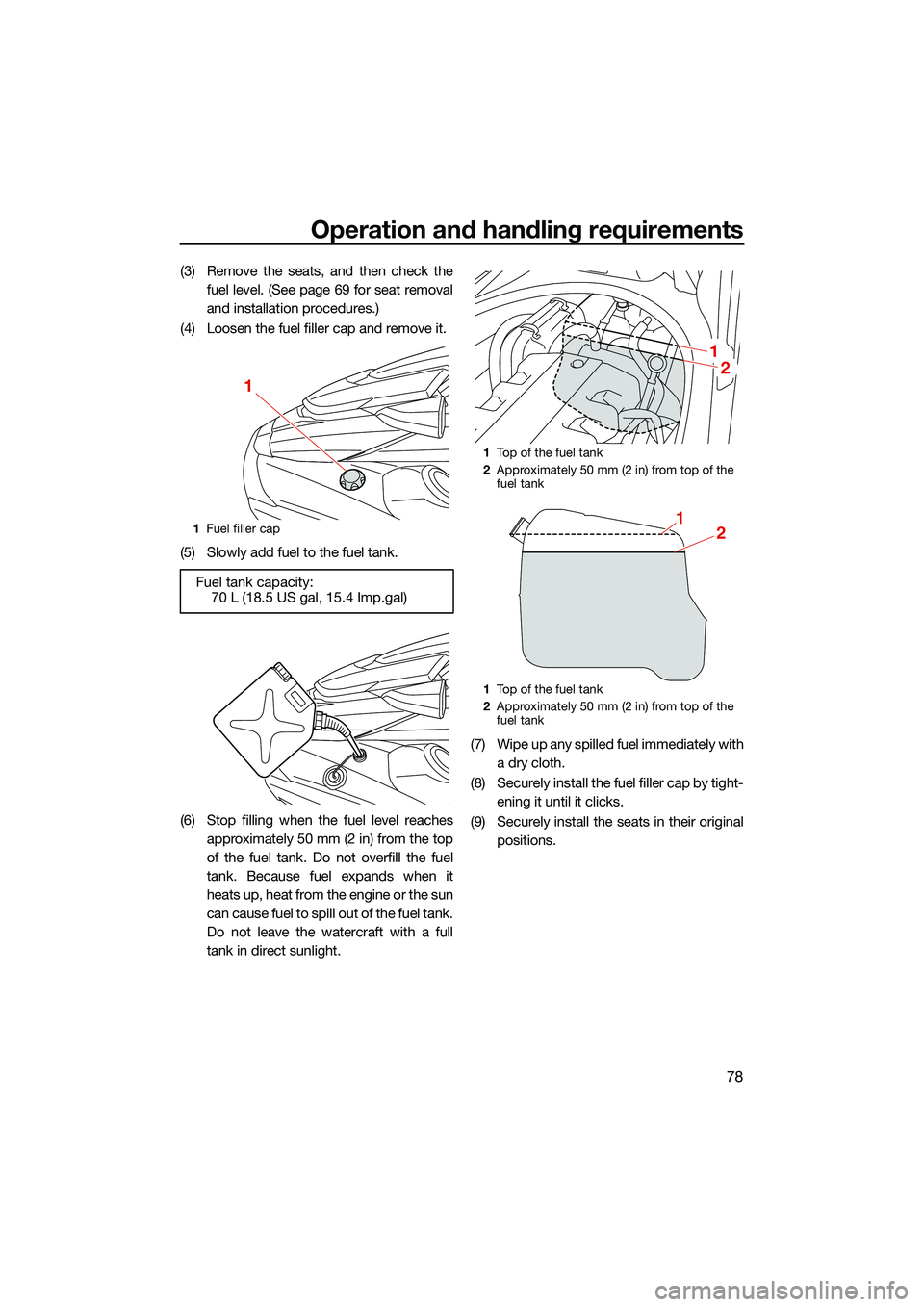
Operation and handling requirements
78
(3) Remove the seats, and then check thefuel level. (See page 69 for seat removal
and installation procedures.)
(4) Loosen the fuel filler cap and remove it.
(5) Slowly add fuel to the fuel tank.
(6) Stop filling when the fuel level reaches approximately 50 mm (2 in) from the top
of the fuel tank. Do not overfill the fuel
tank. Because fuel expands when it
heats up, heat from the engine or the sun
can cause fuel to spill out of the fuel tank.
Do not leave the watercraft with a full
tank in direct sunlight. (7) Wipe up any spilled fuel immediately with
a dry cloth.
(8) Securely install the fuel filler cap by tight- ening it until it clicks.
(9) Securely install the seats in their original positions.
1Fuel filler cap
Fuel tank capacity:
70 L (18.5 US gal, 15.4 Imp.gal)
1
1Top of the fuel tank
2 Approximately 50 mm (2 in) from top of the
fuel tank
1 Top of the fuel tank
2 Approximately 50 mm (2 in) from top of the
fuel tank
2
1
21
UF3V73E0.book Page 78 Friday, October 8, 2021 1:30 PM
Page 88 of 136
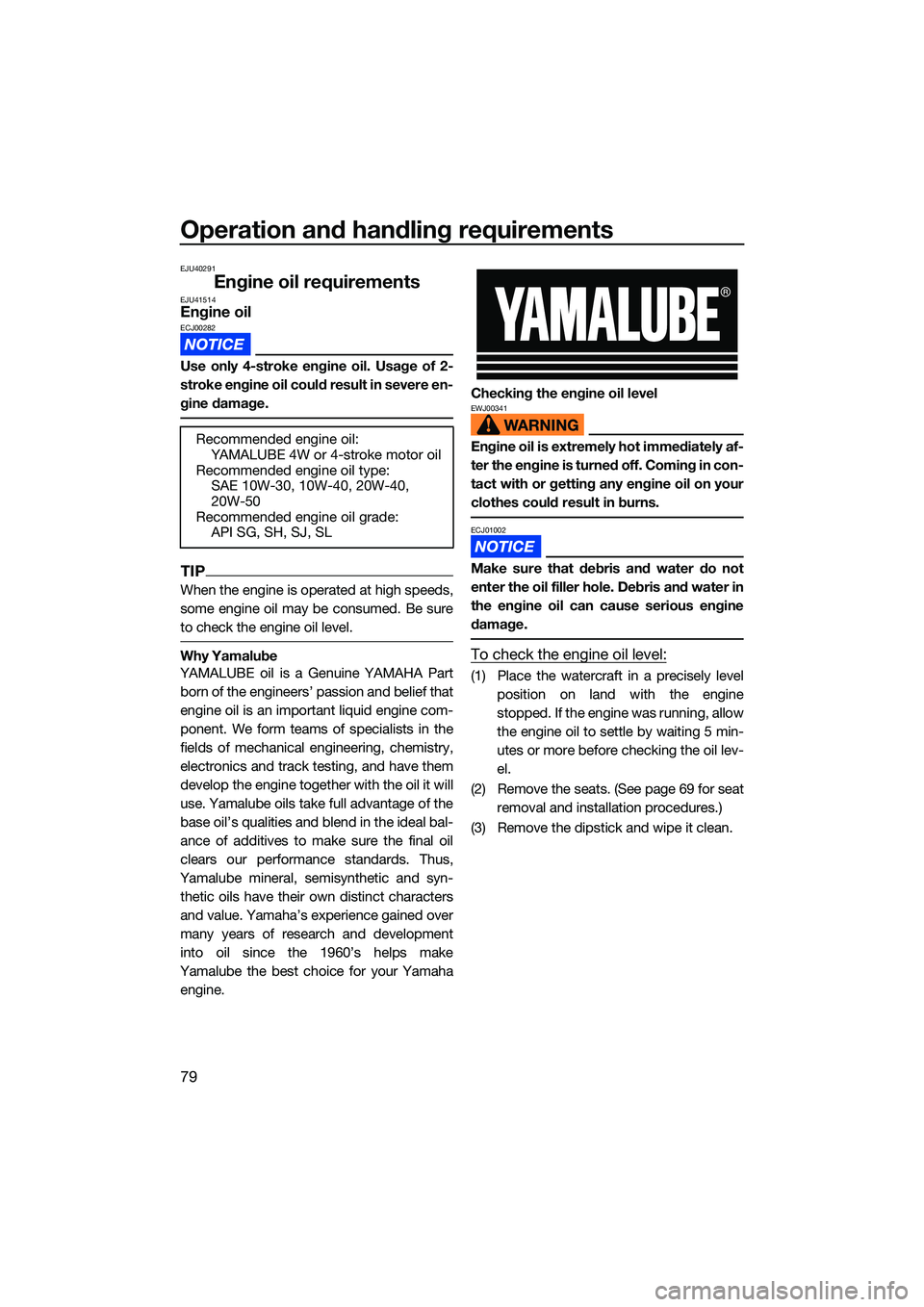
Operation and handling requirements
79
EJU40291
Engine oil requirementsEJU41514Engine oilECJ00282
Use only 4-stroke engine oil. Usage of 2-
stroke engine oil could result in severe en-
gine damage.
TIP
When the engine is operated at high speeds,
some engine oil may be consumed. Be sure
to check the engine oil level.
Why Yamalube
YAMALUBE oil is a Genuine YAMAHA Part
born of the engineers’ passion and belief that
engine oil is an important liquid engine com-
ponent. We form teams of specialists in the
fields of mechanical engineering, chemistry,
electronics and track testing, and have them
develop the engine together with the oil it will
use. Yamalube oils take full advantage of the
base oil’s qualities and blend in the ideal bal-
ance of additives to make sure the final oil
clears our performance standards. Thus,
Yamalube mineral, semisynthetic and syn- thetic oils have their own distinct characters
and value. Yamaha’s experience gained over
many years of research and development
into oil since the 1960’s helps make
Yamalube the best choice for your Yamaha engine. Checking the engine oil level
EWJ00341
Engine oil is extremely hot immediately af-
ter the engine is turned off. Coming in con-
tact with or getting any engine oil on your
clothes could result in burns.
ECJ01002
Make sure that debris and water do not
enter the oil filler hole. Debris and water in
the engine oil can cause serious engine
damage.
To check the engine oil level:
(1) Place the watercraft in a precisely level
position on land with the engine
stopped. If the engine was running, allow
the engine oil to settle by waiting 5 min-
utes or more before checking the oil lev-
el.
(2) Remove the seats. (See page 69 for seat removal and installation procedures.)
(3) Remove the dipstick and wipe it clean.
Recommended engine oil:
YAMALUBE 4W or 4-stroke motor oil
Recommended engine oil type: SAE 10W-30, 10W-40, 20W-40,
20W-50
Recommended engine oil grade: API SG, SH, SJ, SL
UF3V73E0.book Page 79 Friday, October 8, 2021 1:30 PM
Page 89 of 136
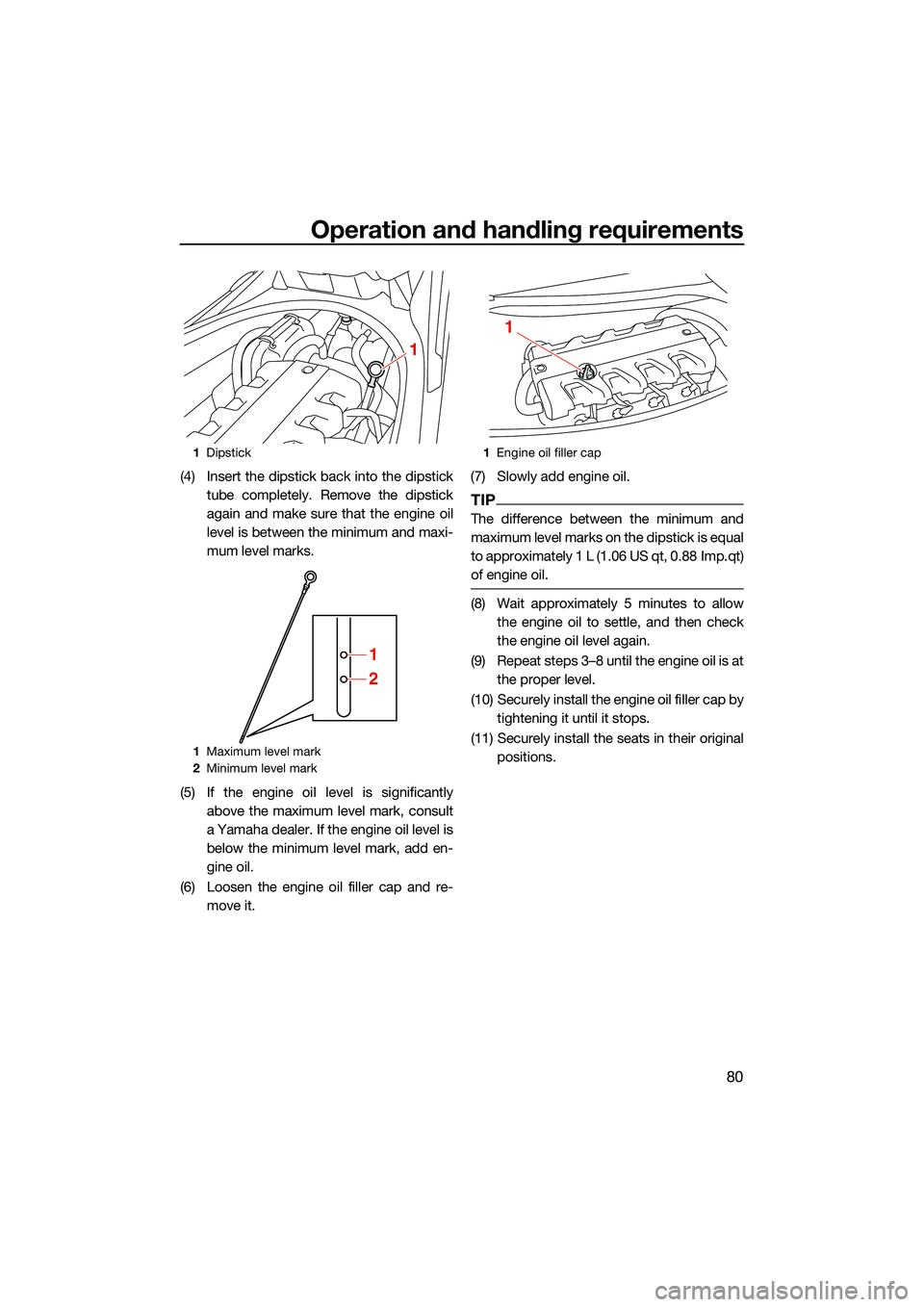
Operation and handling requirements
80
(4) Insert the dipstick back into the dipsticktube completely. Remove the dipstick
again and make sure that the engine oil
level is between the minimum and maxi-
mum level marks.
(5) If the engine oil level is significantly above the maximum level mark, consult
a Yamaha dealer. If the engine oil level is
below the minimum level mark, add en-
gine oil.
(6) Loosen the engine oil filler cap and re- move it. (7) Slowly add engine oil.
TIP
The difference between the minimum and
maximum level marks on the dipstick is equal
to approximately 1 L (1.06 US qt, 0.88 Imp.qt)
of engine oil.
(8) Wait approximately 5 minutes to allow
the engine oil to settle, and then check
the engine oil level again.
(9) Repeat steps 3–8 until the engine oil is at the proper level.
(10) Securely install the engine oil filler cap by tightening it until it stops.
(11) Securely install the seats in their original positions.
1Dipstick
1 Maximum level mark
2 Minimum level mark
1
1
2
1Engine oil filler cap
1
UF3V73E0.book Page 80 Friday, October 8, 2021 1:30 PM
Page 90 of 136
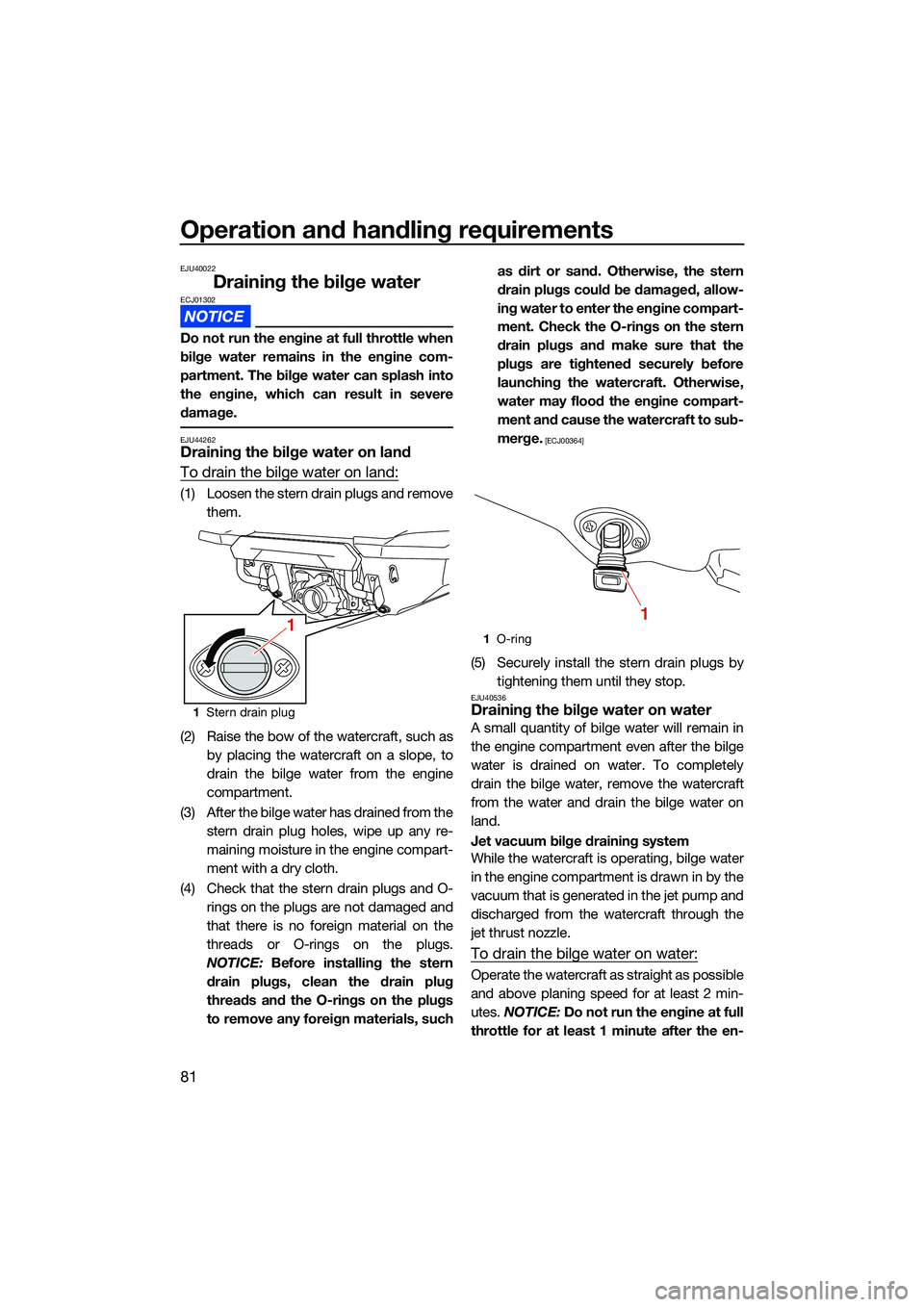
Operation and handling requirements
81
EJU40022
Draining the bilge waterECJ01302
Do not run the engine at full throttle when
bilge water remains in the engine com-
partment. The bilge water can splash into
the engine, which can result in severe
damage.
EJU44262Draining the bilge water on land
To drain the bilge water on land:
(1) Loosen the stern drain plugs and removethem.
(2) Raise the bow of the watercraft, such as by placing the watercraft on a slope, to
drain the bilge water from the engine
compartment.
(3) After the bilge water has drained from the stern drain plug holes, wipe up any re-
maining moisture in the engine compart-
ment with a dry cloth.
(4) Check that the stern drain plugs and O- rings on the plugs are not damaged and
that there is no foreign material on the
threads or O-rings on the plugs.
NOTICE: Before installing the stern
drain plugs, clean the drain plug
threads and the O-rings on the plugs
to remove any foreign materials, such as dirt or sand. Otherwise, the stern
drain plugs could be damaged, allow-
ing water to enter the engine compart-
ment. Check the O-rings on the stern
drain plugs and make sure that the
plugs are tightened securely before
launching the watercraft. Otherwise,
water may flood the engine compart-
ment and cause the watercraft to sub-
merge.
[ECJ00364]
(5) Securely install the stern drain plugs by
tightening them until they stop.
EJU40536Draining the bilge water on water
A small quantity of bilge water will remain in
the engine compartment even after the bilge
water is drained on water. To completely
drain the bilge water, remove the watercraft
from the water and drain the bilge water on
land.
Jet vacuum bilge draining system
While the watercraft is operating, bilge water
in the engine compartment is drawn in by the
vacuum that is generated in the jet pump and
discharged from the watercraft through the
jet thrust nozzle.
To drain the bilge water on water:
Operate the watercraft as straight as possible
and above planing speed for at least 2 min-
utes. NOTICE: Do not run the engine at full
throttle for at least 1 minute after the en-
1 Stern drain plug
11O-ring
1
UF3V73E0.book Page 81 Friday, October 8, 2021 1:30 PM